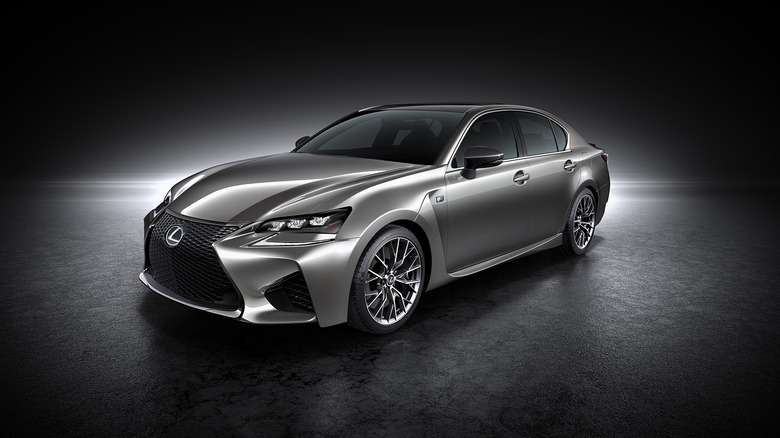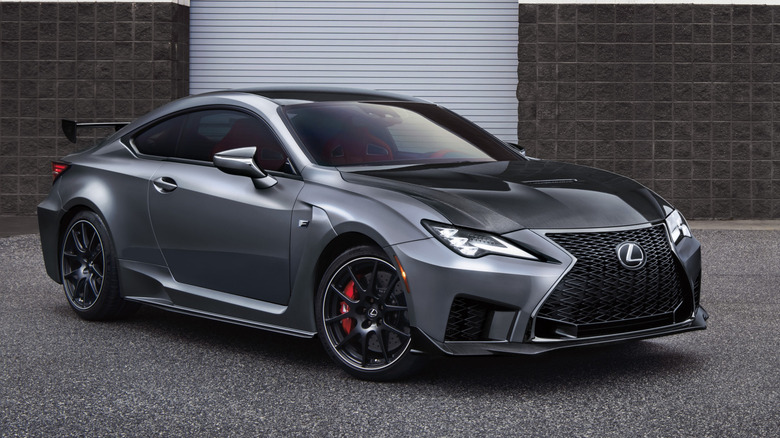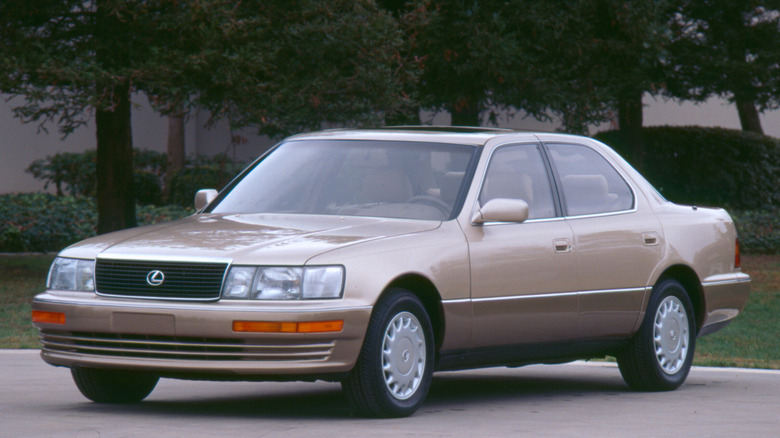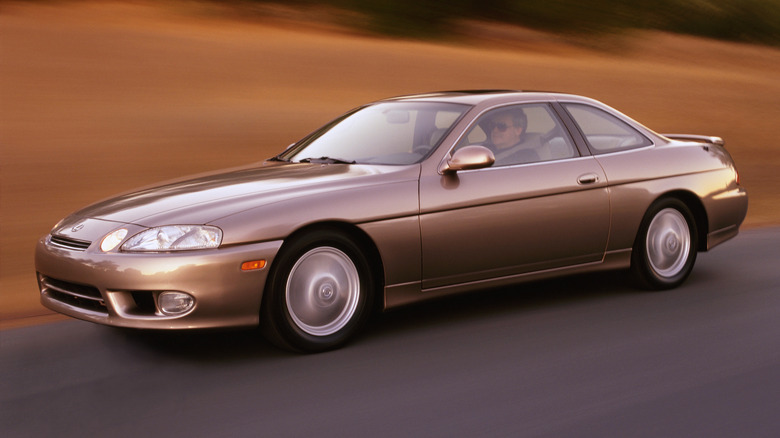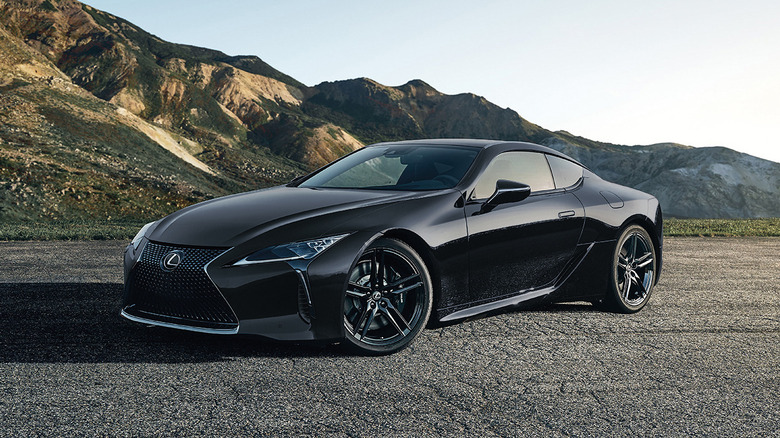5 Of The Best V8-Powered Lexus Models Of All Time
Arguably, Lexus as a brand wouldn't exist without the power and reliability of its many V8 engines. Lexus developed its reputation as a fine automaker owing largely to the original LS400's V8, a legacy which continues to this day. Many of its most famous models feature a diverse array of potent yet understated V8s lurking under the hood, ranging from luxury grand tourers to prestigious super saloons. Of course, V8s aren't the only reason why Lexus models remain popular today, nor are they the only outstanding engine configuration Lexus offered. For instance, many Lexus models house the famous 2JZ engine, and the LFA boasts what some call the best sounding V10 ever produced. But of all the V8-powered Lexus models, which are the greatest out there?
Before anything else, we must first define the concept of "greatest." Because Lexus assembles such a wide range of V8-powered cars, this list will consider qualities considered crucial to each body type. For example, a Lexus LX full-size SUV boasts a V8 engine for different reasons than the svelte two-door LC.
Another factor we'll consider is relative age: Lexus has been around since the late 1980s, and cars of that vintage sport the technology and build quality of their time. While many Lexus models have proven their worth through long-term reliability, we'll assume that each car in this list is in brand-new condition, and primarily compare them with their respective era's contemporaries. So without further delay, let's check them out, beginning with the first ever Lexus model.
Lexus GS F: An average sedan with an extraordinary powerplant
Introduced in 2015 for the 2016 model year, the Lexus GS F marks the Japanese firm's answer to the ever-increasing popularity of super sedans from the likes of Audi, Cadillac, and BMW. It utilizes the same powertrain as the LC500, namely the 2UR 5.0-liter V8 putting out 467 horsepower and 380 lb-ft of torque — slightly less than the LC. It's still more than adequate for a performance sedan, being able to propel the GS F to 60 mph in just 4.4 seconds. However, the naturally-aspirated V8 falls shy of its competitors in terms of power output, lagging behind forced induction offerings like Cadillac's supercharged V8 displacing 640 horsepower.
Sadly, the GS F touts a reputation of relative mediocrity, with reviews criticizing numerous factors including a sluggish transmission, unrefined handling with non-adjustable suspension dynamics, and relatively modest technology for the price point. However, there are virtually no complaints in the engine department, apart from a lack of power in comparison to other super sedans. In short, the GS F represents a rather ordinary, if luxurious, sedan hiding an outstanding V8 engine, the end result of decades' worth of developing some of the most reliable V8s on Earth.
While it might not win a drag race with a Blackwing or a handling contest with an M5, it's still fast enough to notice, and practical enough to use every day, owing to its comfortable full-size four-door layout and relaxed handling. It's a modern Lexus, a performance sedan well-worth defending.
Lexus RC F: A Lexus with true staying power
At first glance, the Lexus RC F superficially resembles the GS F, just with two less doors. Much like the GS F, the RC F suffers from a reputation of being outdated. It's a platform with relatively minimal alterations since its 2014 debut for model year 2015, a problem considering how quickly technology advanced in the past decade.
This means that the RC F is a difficult car to love, with outdated equipment, a heavier and less refined platform, and a naturally-aspirated powertrain that's down on horsepower against its competitors. But, in the same way the GS F found its salvation through its V8, so does the RC F.
Both the GS F and RC F utilize the 2UR-FSE, with an identical power output to match. But, the V8 truly shines with the RC F, well above the GS F and its more ungainly handling (or the IS F, for that matter). It's not a well-oiled sports car to match proper sports cars like the Mercedes AMG-GT, granted, but its handling profile is robust enough that reviews have few complaints apart from its dated shortcomings.
Nevertheless, it features an engine that seemingly never stops providing outstanding service. For instance, the Lexus RC F GT3 utilizes an upgraded 2UR powertrain on a platform dating back to 2015, meaning the RC F GT3 is the oldest vehicle in modern GT grids. Even so, it still remains competitive and dependable today, largely thanks to the 2UR itself being designed with reliability and toughness in mind. Though its days are now numbered, unfortunately, as Lexus announced that it would be discontinuing this model in January 2025.
Lexus LS400: The original Lexus V8
Of course, no list would be complete without the car that started it all, and arguably the greatest Lexus model of the 1990s. The Lexus LS400, marketed as the Toyota Celsior in Japan, represents the progenitor of the Lexus brand in terms of reputation and quality, outperforming contemporary offerings from foreign giants like BMW and Mercedes.
Toyota began development of the LS400 following a request from Toyota president Eiji Toyoda to build "a car that is better than the best in the world," a task labeled by some even within Toyota as impossible.
To this end, Toyota initiated the Circle F Project (F meaning Flagship), with the intent of developing a ground-up design that was more refined, luxurious, and fuel-efficient than any of its German rivals. In defiance of its naysayers, the LS400 not only succeeded, it easily outclassed other Japanese luxury offerings and directly competed with the German automakers. Thanks to its relatively low price point, build quality, and exceptional customer service practices, the LS400 outsold all contemporaries despite a slump in U.S. auto sales.
Lexus developed the 1UZ-FE for the LS400, iterating through 973 prototypes before finalizing the design. The company engineered the V8 to complement the LS400's requirements for smoothness, efficiency, and refinement, features which were prominently advertised. Moreover, its overengineering also cemented Lexus' reputation for reliability, with many engines achieving hundreds of thousands or even millions of miles with regular maintenance. Lexus simply wouldn't be the company it is today without the 1UZ-FE, and its parent, the LS400.
Lexus SC400: Better than a Supra
Lexus launched the first-generation SC in 1991 as a companion car to the LS and Camry-based ES, representing the first three production cars to bear the Lexus badge. Two of those, the LS400 and top-shelf SC400, utilized the 1UZ-FE V8 powertrain. Whereas the LS400 emphasized the 1UZ's smoothness and refinement, the SC instead touted the engine's performance characteristics, and it was genuinely a well-performing engine for its day, a point further emphasized by the SC's platform.
The Lexus SC (meaning Sports Coupe) shares much of its mechanical underpinnings with the fourth-generation Toyota Supra, to the point where people frequently compare the two and label the SC as a high-end Supra derivative. Despite their inherent similarities, the Lexus SC400 is a proper thoroughbred performance grand tourer, serving as the ancestor to the LC mentioned earlier.
Contemporary and post-launch reviews frequently cite its outstanding build quality, brisk acceleration, and comfort, a testament to the reputation of early Lexus vehicles. All of that is before diving into the looks.
The SC400 boasts typical Japanese understated lines throughout the exterior and interior, using lessons learned from high-end Toyotas like the Crown and Century to create an aesthetic which reviews called subtle and elegant.
It follows the typical 1990s rounded-edges trend, but combines it with a traditional grand-tourer design with the long hood and spacious cabin. It may not be as iconic as the Supra people compare it with, but its looks and powerplant both easily stand the test of time regardless.
Lexus LC: The finest Japanese grand tourer of the 21st century
The Lexus LC (Luxury Coupe) serves as a return to form for the high-end two-door format lost in 2010, as Toyota discontinued the Lexus SC. Its handsome lines sit somewhere in between the exclusive Lexus LFA and the more typical RC, representing what Lexus labels as the culmination of its performance-oriented developments throughout the 2000s and 2010s. Much like the LS400, the LC underwent years of developmental iterations, first showcased as a concept car — the LF-LC, which debuted in January 2012 at the Detroit Auto Show.
It took Lexus five years of iterations before the LC finally joined the lineup as the marque's new flagship, debuting in 2017 as the LC500 and LC500h. The LC was an entirely original design which utilized a bespoke platform: GA-L, or Global Architecture-Luxury, coupled with a 471-horsepower V8 and a 10-speed automatic transmission in non-hybrid trim.
The 5.0L 2UR-GSE is a classic naturally-aspirated powerplant which emphasizes the performance characteristics Lexus refined in its "F" line. Similar to most other V8s Lexus offers, the engine retains its characteristic smoothness and fuel-efficiency, utilizing various additions like 32 valves and VVT-iE variable valve timing, D-4S direct injection, and an active exhaust to achieve the best of both worlds.
Therefore, not only does this engine produce respectable power figures for a high-end grand tourer, but it also boasts a level of refinement typical of more traditional luxury sedans. And lastly, the 2UR-GSE is also one of Lexus' most reliable engines in its current lineup, with 2UR-equipped models typically enjoying many trouble-free years.

